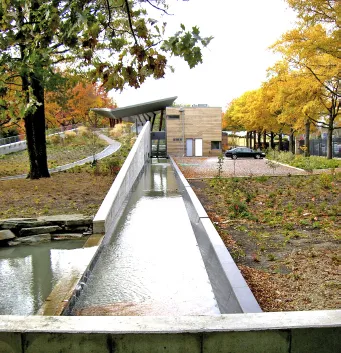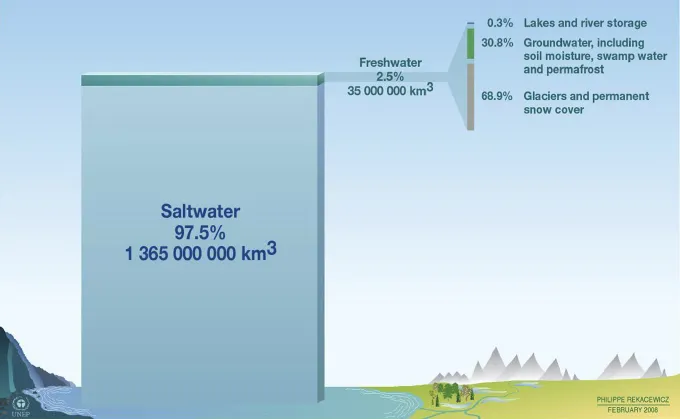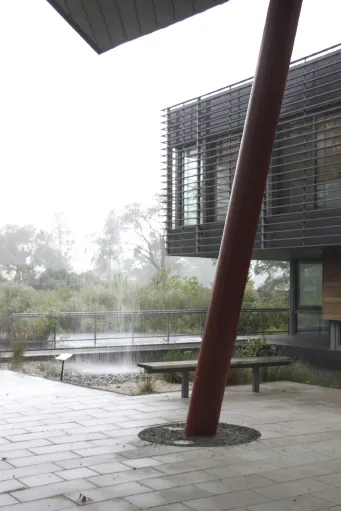
eBook - ePub
Designing Rainwater Harvesting Systems
Integrating Rainwater into Building Systems
This is a test
- English
- ePUB (mobile friendly)
- Available on iOS & Android
eBook - ePub
Designing Rainwater Harvesting Systems
Integrating Rainwater into Building Systems
Book details
Book preview
Table of contents
Citations
About This Book
Water conservation is one of the most effective sustainable design practices, yet few professionals know how to collect and use rainwater effectively. Rainwater Harvesting the first comprehensive book on designing rainwater harvesting systems. It provides practical guidelines for developing a rainwater harvesting strategy, taking into account climate, public policies, environmental impact, and end uses. Case studies are included throughout. Rainwater Harvesting is a valuable reference for architects, landscape architects, and site engineers.
Frequently asked questions
At the moment all of our mobile-responsive ePub books are available to download via the app. Most of our PDFs are also available to download and we're working on making the final remaining ones downloadable now. Learn more here.
Both plans give you full access to the library and all of Perlego’s features. The only differences are the price and subscription period: With the annual plan you’ll save around 30% compared to 12 months on the monthly plan.
We are an online textbook subscription service, where you can get access to an entire online library for less than the price of a single book per month. With over 1 million books across 1000+ topics, we’ve got you covered! Learn more here.
Look out for the read-aloud symbol on your next book to see if you can listen to it. The read-aloud tool reads text aloud for you, highlighting the text as it is being read. You can pause it, speed it up and slow it down. Learn more here.
Yes, you can access Designing Rainwater Harvesting Systems by Celeste Allen Novak, Eddie Van Giesen, Kathy M. DeBusk in PDF and/or ePUB format, as well as other popular books in Architecture & Urban Planning & Landscaping. We have over one million books available in our catalogue for you to explore.
Information
Chapter 1
The Importance of Rainwater Harvesting
Rain water harvesting and conservation aims at optimum utilization of the natural resource that is Rain Water, which is the first form of water that we know in the hydrological cycle and hence is a primary source of water for us. The Rivers, Lakes, and Ground Water are the secondary sources of water. In present times, in absence of Rain Water harvesting and conservation, we depend entirely on such secondary sources of water. In the process it is forgotten that rain is the ultimate source that feeds to these secondary sources. The value of this important primary source of water must not be lost. Rain water harvesting and conservation means to understand the value of rain and to make optimum use of Rain Water at the place where it falls.—India: Rain Water Harvesting and Conservation Manual1

Figure 1.1 Queens Botanical Garden Visitor and Administration Center is an example of integrated rainwater harvesting system design.
WATER CAPITAL
Water is the only commodity on Earth for which there is no economic substitute. Seventy-five percent of the Earth’s surface is covered in water, yet only 2.5 percent of it is suitable for human consumption. Of that 2.5 percent, most is locked in polar ice caps or hidden beyond the reach of commercial technologies.2 All life forms on the planet depend on water to survive. Simply stated, water is the basis for all life on Earth.
The more technologically advanced humans become, the more water is consumed on a per capita basis. Electricity use within a typical home requires 250 gallons (almost 1,000 L) of water per day per person; the manufacturing processes of computer chips, televisions, and cell phones require water, and the production of a half-gallon (roughly 2L) bottle of soda can take over 1.3 gallons (5 L) of pure water.3 Even the production of food requires tremendous amounts of water, as producing 1 pound (0.5 kg) of chicken and 1 pound (0.5 kg) of beef requires over 1,600 gallons (6,000 L) of water!4 Historically, an abundance of water, as well as water scarcity, has affected both the growth and decline of every civilization. History teaches that finite water resources need to be managed with the utmost care.

Figure 1.2 EARTH A Graphic Look at the state of the world5
(Source: Igor A. Shiklomanov, State Hydrological Institute (SHI, St. Petersburg) and United Nations Educational, Scientific and Cultural Organisation (UNESCO, Paris), 1999. Image courtesy of UNEP.)
As profound as our dependence on water is, there is an equally profound lack of knowledge concerning where water comes from and how it is best and most efficiently used as a public and private resource. According to the Environmental Protection Agency (EPA), the following statistics underscore the challenges faced by architects, engineers, and public policy makers as they face looming freshwater shortages:
- The average American directly uses 80 to 100 gallons of water each day, but supporting the average American lifestyle requires over 1,400 gallons of water each day.
- Agriculture is the largest consumer of freshwater: worldwide, about 70 percent of all withdrawals go to irrigated agriculture.
- Only 1 percent of the world’s freshwater is accessible to humans.
- Forty percent of America’s rivers and 46 percent of its lakes are too polluted to support fishing, swimming, or aquatic life.
- Power plants in the United States use 136 billion gallons of water per day, more than three times the water used for residential, commercial, and all other industrial purposes.6
In addition, scientists and researchers are describing a “peak water” crisis for water use throughout the world. As a response to these issues, professionals are developing new strategies to conserve and effectively use water resources.
Peak Water
The planet is getting thirstier as a growing worldwide population is using fresh water resources. Dr. Peter Gleick, president of the Pacific Institute, has coined “peak water” as a description for the world’s water crisis. This concept describes the lack of sustainably managed water throughout the world, just as “peak oil” refers to the lack of oil reserves globally. According to Dr. Gleick, there are three major definitions for peak water. These are:
- Peak Renewable Water: The limit reached when humans extract the entire renewable flow of a river or stream for use.
- Peak Non-Renewable Water: Groundwater aquifers that are pumped out faster than nature recharges them—exactly like the concept of “peak oil.” Over time, groundwater becomes depleted, more expensive to tap, or effectively exhausted.
- Peak Ecological Water: The point where any additional human uses cause more harm (economic, ecological, or social) than benefit. For many watersheds around the world, we are reaching, or exceeding, the point of “peak ecological water.”7
The design challenge is to reverse the direction of peak water so that it is not a linear loss of water, but a regenerating system that allows humans to participate in the continuation of the hydrologic system.
One response to the water supply challenges is the re-creation of one of the world’s oldest water supply systems: rainwater collection. Rainwater collection, or rainwater harvesting, involves the capture of water from roofs and/or impervious/pervious surfaces. The roofs of buildings, schools, offices, large data distribution centers, and agricultural buildings can serve as the contributing drainage area for a given system. Once captured within the rainwater harvesting system, the quality of the runoff water may be improved via physical and biological processes including filtration, disinfection, and other treatment strategies. New approaches in plumbing design are using site-collected rainwater/stormwater to provide all or part of a building’s and its site-related water needs. This results in a reduction of stormwater runoff volumes leaving a site, while at the same time providing a new source of water to reduce the burden on potable water supplies.

Figure 1.3 At the Queens Botanical Garden, rainwater is a valuable resource.
(James Wasley/Atelier Dreiseitl)
Water conservation and stormwater management are two of the most effective sustainable design practices available to architects and engineers. Rainwater collection conforms to the goals and objectives of low-impact development, which aims to mimic the predevelopment site hydrology by using site design techniques that store, infiltrate, evaporate, and detain runoff.8 Reducing the runoff from storm events via rainwater harvesting strategies provides benefits to property owners, including lower municipa...
Table of contents
- Cover
- Contents
- Title
- Copyright
- Preface
- Acknowledgments
- Chapter 1: The Importance of Rainwater Harvesting
- Chapter 2: System Planning and Policies
- Chapter 3: Water for Thirsty Buildings
- Chapter 4: System Elements
- Chapter 5: Maintenance and Safety
- Chapter 6: 21st-Century Interviews
- Appendix A
- Appendix B
- Supplemental Images
- Index
- Access to Companion Site
- End User License Agreement